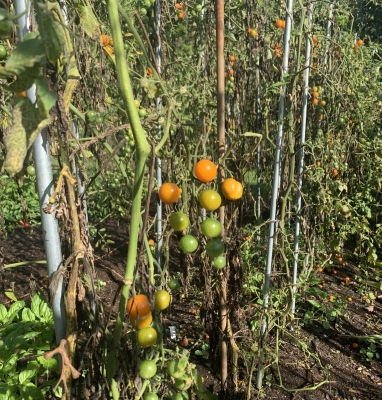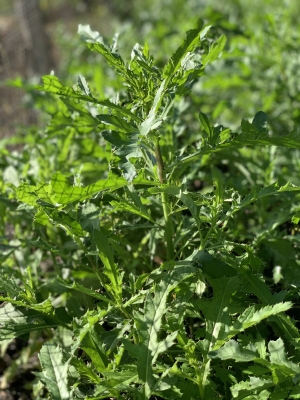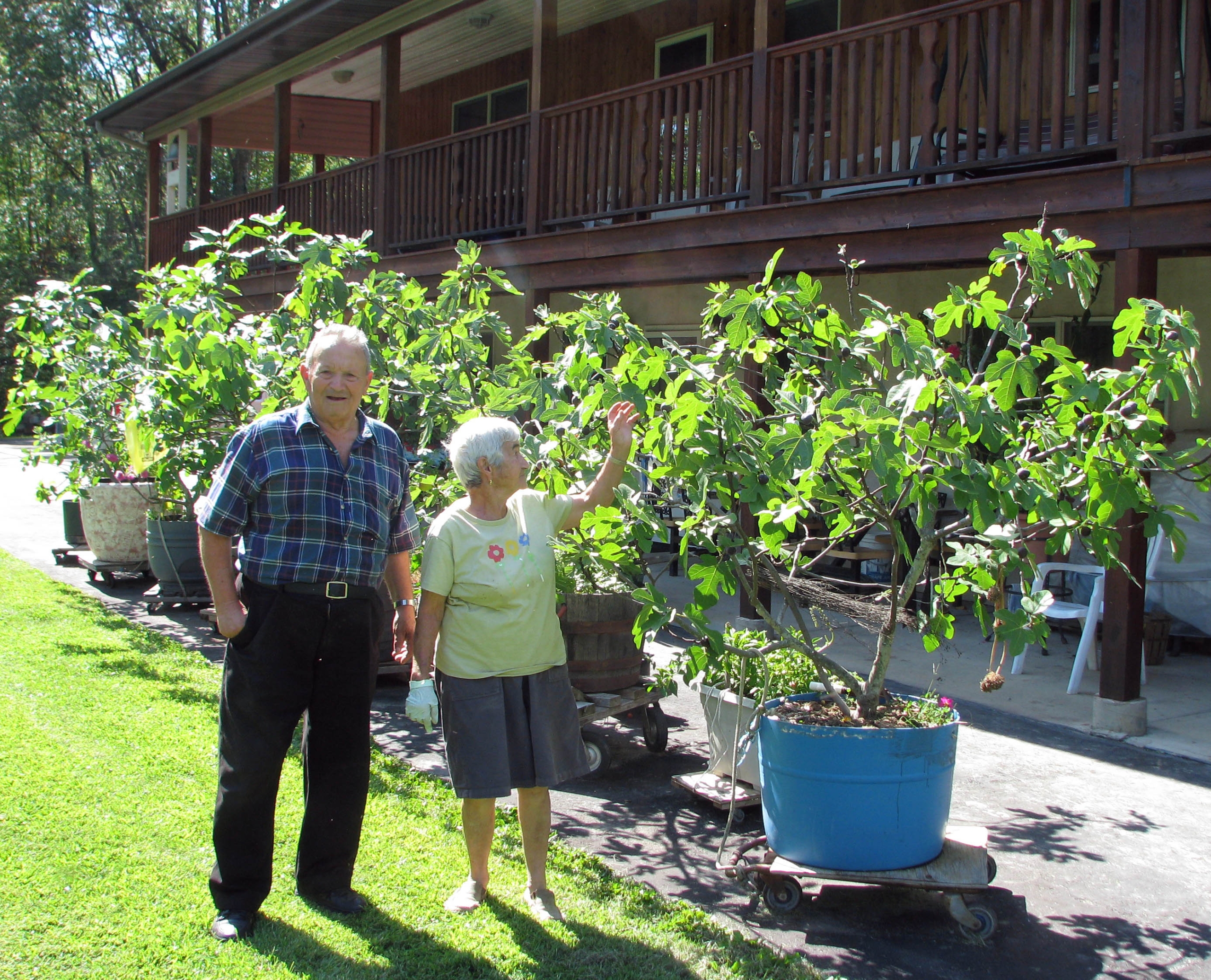RE-EVALUATION
The Worst?!
Every year, when I tell my longtime friend Vicki, “This year is the best garden year ever,” she smiles and rolls her eyes in a friendly way. But it’s true: Another year of gardening experience, better varieties to grow (Picnic Orange pepper of last year is now on my must-grow list); improved weed management (tarping added to my list); better pest control (the dreaded spotted wing drosophila on blueberries); etc.

Picnic orange pepper
This year, Vicki was surprised when I finished my annual sentence with “the worst year ever.”
She, of course, asked why. I spared her, but will not spare you, all the gruesome details, as far as I can determine.
Blame the Weather
Weather is always a good scapegoat for farmers, farmdeners, and gardeners, influencing plants in so many ways. Disease, for instance. Pollination. How vigorously plants grow, influenced by not the weather only above ground, but also below ground.
Tomatoes fared particularly poorly this year. Excessive rainfall promoted all the usual tomato diseases — septoria leaf spot, early and late blight, and anthracnose — in spades this year.
Tomatoes and other plants also suffered below ground. Most years, a little extra rainfall would not be a problem in my reasonably well-drained clay loam soil. I accept full blame for what went on below ground this year.
Vegetables here get there daily drink automatically via drip irrigation. I usually go outside to the well pump that serves the garden and turn off the valve during excessively rainy periods, but this year I was lazy and didn’t bother, figuring each time that the rain would soon cease. It’s a bad move — or, rather, non-move — in a summer when the sky dumped 7.5” more inches than than any other summer for the last 127 years. (That local data is available to me from the nearby Mohonk Preserve weather station.) Tomatoes, even the relatively disease resistant San Marzano tomatoes, corn, and eggplants especially suffered.
I wonder if all the water also washed too much nutrition down out of the ground. I took leaf samples for tissue tests from corn and tomato plants to find out what plants actually took up. A soil test tells what nutrients are in the ground; uptake by plants can be poor if, for instance, the ground is waterlogged, which interferes with root function.
The test indicated that the the plants were low in nitrogen, an element that is soluble and can wash down and out of the ground. I do find those results odd because I use copious amounts of compost, a one-inch depth laid atop the ground, every year. Compost releases only some of its nitrogen in soluble form by the action of soil microorganisms, and its benefit in theis way isn’t just for the year of application. It’s the gift to the soil that keeps on giving. I guess it’s possible that as soon as it gave, it washed down and out of the root zone.
A Good Year for Weeds
Weeds, being what they are, were unfazed by this summer’s rainy weather, the less than perfect conditions for garden plants suiting the weeds just fine. Thistles secured their position here, from which they aggressively spread.

Canadian thistle
I spent lots of time pulling thistles, hoeing them, spraying them with an organic herbicide (Biosafe), flaming them, weed whacking them, and smothering them beneath wood chips. Ha! they just kept coming back, upsetting what I thought was our tenuous truce. I do manage to maintain the upper hand in the vegetable gardens, at least.
In rougher portions of the farmden Japanese knotweed and poison ivy thrived.
Too Much Experiment?
I also accept one-hundred percent of the blame for this season’s poor showing of the second wave of vegetable seedlings, which included cucumber, summer squash, late cabbage, and cauliflower.
Almost forever I’ve used the same home made potting mix for all my seedlings, most house plants, and potted fruit plants, such as figs. It’s not a secret mix, just equal parts compost, peat, garden soil, and perlite, with a cup of soybean meal per 10 gallons of mix thrown in for an organic, slow release, long lasting source of extra nitrogen.
In an effort to be environmentally sound and avoid using peat moss, which is arguably a nonrenewable resource formed in fragile ecosystems, I tried one of the substitutes, which shall remain nameless until I test it more thoroughly in different proportions within the mix. (Then again, I may never get around to that as I remember what Charles Dudley Warner wrote in his 1870 book My Summer in the Garden, “I have seen gardens which were all experiment, given over to every new thing, and which produced little or nothing to the owners, except the pleasure of expectation.” At any rate, all the plants in that new mix just sat in the their containers.
My Fault, Again
The weather and I conspired for another calamity this season: the late spring frost. Usually I hew to set planting dates, honed over years of experience here at the farmden and taking into account global warming. But this past spring was warming so, so slowly and so, so steadily.
My potted figs were just right in their development — buds swelling but not yet unfurling, when I moved them outdoors in April. I also planted tomato seedlings outdoors in the middle of May, a week or two earlier than my “set” date.
Then I became a very temporary — one night — climate denier. (Actually, a weather denier.) Frost hardly below freezing was predicted. For insurance, I could have lugged my many potted figs into nearby shelter. I did throw some row cover over the tomatoes. I figured it would get chilly but not THAT cold.
I was wrong. On May 18th, the mercury dropped to 27 degrees Fahrenheit. Fig branches died back some which, along with the bad potting soil, prevented them from bearing this season. Tomatoes froze almost to the ground, so needed replanting. Fortunately, I had extra seedlings, enough to replant all the frozen ones.
Live and learn. Next year will be better, perhaps the best garden ever.




Dear Lee,
I think you have something with your comments about Tomatoes
I had a great tomato crop this year in Newburgh despite the rain. I attribute that to the fact that they were planted over what used to be a paver pool deck so lots of sharp stone dust and sand mixed in the soil. I think I only watered two or three times the whole season. I did have a very thick sweet peat mulch which i feel mitigates the up and down of moisture level in the soil. Within the last two or three weeks they suffered from disease. A spraying of copper fungicide helped and they were still pretty vigorous, especially the plum tomatoes and sun gold cherry.. Eggplant still vigorous but fruit just about exhausted.
I’m thinking of bringing in a load of sharp masons sand for that part of my garden where there was no previous pool deck/sand/stone dust.
All that would help with tomato problems.
Thanks for honesty
So sorry Sir, but I was happy to hear that an experienced farmderer like you had similar problems to me, a newby gardner. Hope next year will be your “best year ever”
Best,
Prema
I’m optimistic.
MINE TOO Nuff Said. Asheville NC. So many bad outcomes I wouldn’t know where to start. At first I took the blame for using bad soil mix in my raised beds. But now I blame mostly freak climate events and mostly exonerate myself. I feel way better (or less terrible)) after reading your post. Thank you for sharing!!
I don’t know if that makes me feel better (companionship in trouble) or worse (such widespread bad season).
My roses had a black spot blight that they caught from black-eyed Susans that all came down w the same disease the summer before. I removed every one of them, but it must have been in the soil. I use copper sulfate spray and neem oill. What more to do?
Black spot of roses only infects roses. The disease overwinters on fallen leaves and on lesions on the canes. Neem oil or copper sulfate should help keep it at bay if sprayed at 7-10 day intervals when temperatures are warm, 75 to 90 degrees F. The fungus needs moisture to thrive so pruning to provide good air circulation among the cases and drying also will diminish disease.
Aw, geeze. Very sorry to hear this.
We’ve had a horrible year here in our WNY garden for berries, cukes, and squash, chief complaint being the Spotted Wing Drosophila (SWD) in the raspberries and in what would otherwise have been a spectacularly productive blackberry patch. Fortunately, our blueberries matured fairly early and the adjacent raspberry patch acted as “trap crop”?
I’ll go search here to see if I can find your solutions for SWD. (We have 6 of your 8 books, if the solution lies in one of those, please say which.)
Cornell’s Small Fruits Specialist for our region said one of her growers puts banana slices *on* the hummingbird feeders (hummingbirds, for readers who may not have already heard, reputedly enjoy dining on SWD), to draw the dastardly flies directly to the feeder.
Meanwhile, we’re culling berry fruits as quickly as we can, pouring boiling water over them in a metal pot, to disrupt the SWD lifecycle, but are having trouble keeping up during shorter days spent mostly at day jobs.
You probably know this, but refrigerating blueberries for 36(?) hours after harvest kills the larvae, and you can still eat the blueberries.
Oh, and – we’re hoping the 2-3 wasps known to prey on SWD are soon available for purchase by the public.
What wasps are they?
A couple hours due north of you, I had the same kind of season. For some reason the peppers did wonderfully, but the tomatoes were awful and the eggplants just sat there all summer. Cucumbers started producing late August and were lackluster. Greens were great!! Commenting on the seedlings, I almost threw out my pepper starts this year because of “failure to thrive”. I used Black Gold mix and later I was told it was terrible by several people who are accomplished seed starters. Also, I learned from Joe Lamp’l, that coir in the mix can really shut down growth as well. Note to self….here’s to a much better year next year!!
Live and learn. Peppers were also very good this year here.
A disappointing year here in Upstate NY as well. Sketchy weather conspired with over-busy gardeners and the result was not good. Already planning next year!
So sorry to hear about your garden this year. The problem with a bad gardening year in cold climates is the long wait for next season’s “do overs”!
My garden had a terrible season too. Here in Madison, WI we had the opposite problem. We didn’t receive any meaningful rainfall in May, June or July! Watering was a full time job. It felt like I couldn’t make the garden ground moist! Weeds grew great right through it. Ugh.
Silver lining: my potted figs seemed happy and ripened this year.
I know about this year’s Madison weather. I still have a good friend from when I lived there way back when. He was bemoaning the drought.
This year I tried a new seed source that carries only heirloom seeds and blamed the sad results on inferior varieties. It’s interesting to see that so many of you have also had poor results. Next year will be better.
I have to add, however, that it was the best year ever for salad greens.
True about salad greens, but they’re always good.
In our central NJ town along Raritan Bay, our cukes and kale were super productive, but tomatoes were a bit of a dud. The plants are huge and healthy, but not very productive.
I must give credit to your weed-free gardening method, which we’ve been using for more than a decade.
Thistles. There’s a little quip about thistles. Goes somewhat like, cut them in may, they’ll be back in a day. Cut them in June, they’ll be back soon. Cut them in July, they’ll be back in a while. Sigh
Actually, there’s something even better about timing to kill — research. I’m currently studying https://cropwatch.unl.edu/organic/thistle. Perhaps something to try.
Lee, do you have any thoughts about the effects of the smoke? I was wondering if the changed the quality of the light and air it had a detrimental effect. I also wonder if it left some residue unless washed off.
Mostly, the impact would be negative, I would think. But not necessarily significant. Some information from the web indicates that haze and reduced air quality from wildfire smoke can result in both negative and positive impacts on crop growth. The first negative impact is a reduction in light availability, which can reduce crop photosynthesis. Wildfire smoke in the atmosphere can reflect portions of incoming sunlight, thus reducing the total amount available to plants. The degree of effect probably depends also on the plant. The second negative impact caused by wildfire smoke is an increase in ground-level ozone. Ground-level ozone can be both harmful to human health and crop growth. Wildfires can emit various air pollutants which can form ozone when reacted with sunlight. Ozone can cause harm to plant tissue during respiration.
In contrast to negative impacts caused by reduced sunlight and increased ozone, wildfire smoke in the atmosphere can also have positive effects on crop growth. One positive effect is that not only can wildfire smoke reflect sunlight, it can also scatter sunlight. By scattering the light, this can allow light to penetrate deeper into the crop canopy and increase plant photosynthesis. Furthermore, when light is scattered and direct sunlight is reduced, this can also lower leaf surface temperatures which can benefit crops under drought stress. Lower leaf temperatures can reduce the amount of transpiration (water movement and evaporation from the plant) needed to cool the plant and reduce overall water stress.